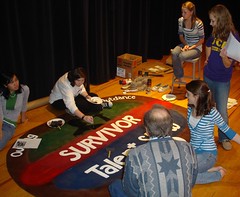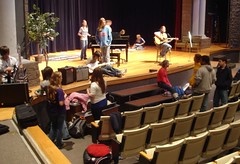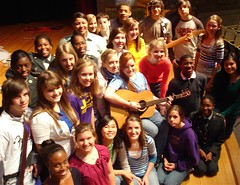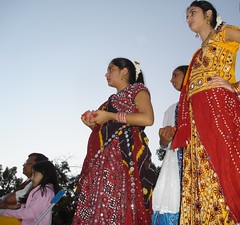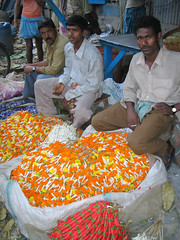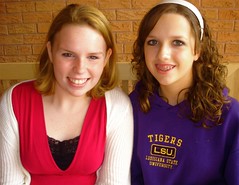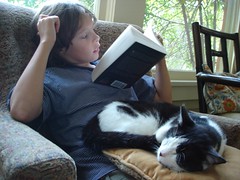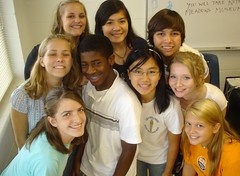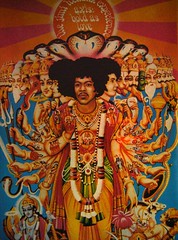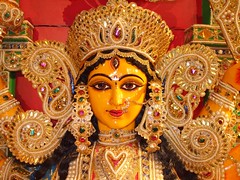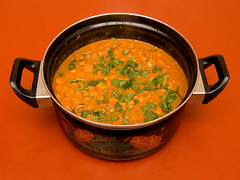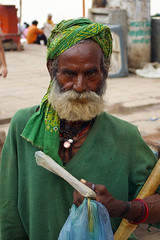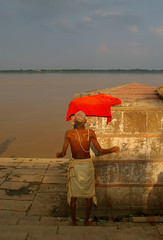Grab a program and get an adult signature (teacher or parent) on it to get 3 bonus points on attending the Talent Show.
The purpose of the show is to give young talent an opportunity to grow and to offer the audience a place to party.
Cookies and cokes available at the show for $1.
Admission is $3.
Thursday, November 29, 2007
Comparing the George Washington-led struggle with the Gandhi-led revolution against the british; paper due Wed, Dec 5

George Washington Statue at Federal Hall, Wall Street, New York City (Dry Brush Effect, Black and White)
Originally uploaded by Scandblue
Gandhi and the people of India vs the British
and George Washington and the American colonists vs the British.
15 pts
Wed, Dec 5
Please TYPE on 2 sheets.
a) Turning point battle(s). Brief descriptions (exs: the Massacre at Amritsar and the Salt March).
b) Begining & end of each independence movement. Dates and brief descriptions (ex: Gandhi’s arrival in India in 1915 and the exit of the British in 1947).
c) Brief biographies (use 3 dates; make sure of the facts of both by your research).
d) Maps - India and the 13 colonies. Principal cities. Color.
e) Brief description of the allies (Gandhi’s were the press, some ministers and wealthy liberals in Europe and the US).
f) Description of the issues that led to the conflict (ex: salt tax, unfair landlords, the massacre by soldiers at Amritsar).
g) Strategies of warfare (ex: non-violence, use of press, use of courts).
h) Documentation (use “according to“ at the end of the first and second paragraphs).
i) Snacky title and explanatory subtitle.
Wednesday, November 28, 2007
Talent Show 2011, CMHS: Fri, Nov 30, 6:30 pm, PAC
Class of 2011 production team . . .
Performing:
Victoria Wade—“Heaven” dance
Rachael Trafford—String duo
Daniel McFarland—String duo
Joy Shan—piano part of “Hey Jude”
Steven Cox—“Hey Jude”
Karen Ezelle—acoustic on “Hey Jude” and “Realize”
Erin Davis—“What is This Feeling”, “Realize”
Emma-Claire Hughes—backup on “Good Morning Baltimore”
Rachel Carson—backup on “Good Morning Baltimore”
Lindsey Griffith—“Who Knew?” on acoustic
Thomas Carter—“Cancion”
Nick Tingle—Rock guitar medley
Rebecca Gorham—“Good Morning Baltimore”
Tori Smith— Henry skit
Monica Reans—Henry skit
Backstage:
Camry Smith—Stage crew
Sedia Williams—Stage crew
Maya Hudson—Stage crew
Octavis Johnson—Stage crew
Jessica Jackson—Stage crew
Codi Cummings—Stage Art
Jessica Cruzan—Stage Art
Emma Meek—Stage Art
Joy Shan—Stage Art
Rachel Carson—Stage Art
Elissa Little—Light and Sound board
Bitsy Hamiter—Light and Sound board
Matthew Giglio—Stage crew
Alex Morgan—Stage crew
Laykin Smith, Stage crew
Adam Garcia—Stage Art
Rebecca Gorham—Stage Art
Performing:
Victoria Wade—“Heaven” dance
Rachael Trafford—String duo
Daniel McFarland—String duo
Joy Shan—piano part of “Hey Jude”
Steven Cox—“Hey Jude”
Karen Ezelle—acoustic on “Hey Jude” and “Realize”
Erin Davis—“What is This Feeling”, “Realize”
Emma-Claire Hughes—backup on “Good Morning Baltimore”
Rachel Carson—backup on “Good Morning Baltimore”
Lindsey Griffith—“Who Knew?” on acoustic
Thomas Carter—“Cancion”
Nick Tingle—Rock guitar medley
Rebecca Gorham—“Good Morning Baltimore”
Tori Smith— Henry skit
Monica Reans—Henry skit
Backstage:
Camry Smith—Stage crew
Sedia Williams—Stage crew
Maya Hudson—Stage crew
Octavis Johnson—Stage crew
Jessica Jackson—Stage crew
Codi Cummings—Stage Art
Jessica Cruzan—Stage Art
Emma Meek—Stage Art
Joy Shan—Stage Art
Rachel Carson—Stage Art
Elissa Little—Light and Sound board
Bitsy Hamiter—Light and Sound board
Matthew Giglio—Stage crew
Alex Morgan—Stage crew
Laykin Smith, Stage crew
Adam Garcia—Stage Art
Rebecca Gorham—Stage Art
Class of 2011 Talent Show, Fri, Nov 30, 6:30 pm, CMHS, Shreveport
Almost all the people involved in the Freshman talent show for the Class of 2011, CMHS. Please plan to attend so you can enjoy your classmates and support these performers and the production team.
Tuesday, November 27, 2007
Semester Exam Schedule, Dec 19 - 21
The basic schedule each day will be -
8:30 - 8:40 homeroom
8:45 - 10:30 exam
10:30 - 10:40 break
!0:45 - 12:30 exam
12:30 - 1:00 lunch
Students dismissed after exams.
1 - 3:30 teachers at work in classrooms.
Wed, Dec 19
exams 3rd and 4th periods
Th, Dec 20
exams 1st and 5th
Fri, Dec 21
exams 2nd and 6th
The geography exam will consist of
a) 100 multiple-choice, open notes questions taken from the tests given in the course of the semester and placed upon this web site.
b) One hand-sketched map quiz.
Choose from Mississippi Valley, Arabia, Israel & neighbors, India.
c) Brief essay: topics to be announced.
8:30 - 8:40 homeroom
8:45 - 10:30 exam
10:30 - 10:40 break
!0:45 - 12:30 exam
12:30 - 1:00 lunch
Students dismissed after exams.
1 - 3:30 teachers at work in classrooms.
Wed, Dec 19
exams 3rd and 4th periods
Th, Dec 20
exams 1st and 5th
Fri, Dec 21
exams 2nd and 6th
The geography exam will consist of
a) 100 multiple-choice, open notes questions taken from the tests given in the course of the semester and placed upon this web site.
b) One hand-sketched map quiz.
Choose from Mississippi Valley, Arabia, Israel & neighbors, India.
c) Brief essay: topics to be announced.
Comparing two giants: India and China
Students were asked to make a graphic comparison between India and China using the RMQRWA.
1. Maps that show the relative size, which is about 3 to one.
2. Graphs that compare
a) populations
b) population density
c) area.
China has a Communist government that has been modified: it has dropped economic control.
India is a democracy.
The US alliance with India is strained by our partnership with Pakistan. Tens of billions of dollars of US aid to Pakistan has been designated for control of terrrorists, says NPR.
Today , says Time magazine,top US students are learning Mandarin Chinese. Will students of the next generation want to learn Hindi?
China, which continues with its successful One family, One Child policy, has achieved a certain level of population control. India has no such control and its population is expected to surge past China's in the near future, according to Newsweek.
1. Maps that show the relative size, which is about 3 to one.
2. Graphs that compare
a) populations
b) population density
c) area.
China has a Communist government that has been modified: it has dropped economic control.
India is a democracy.
The US alliance with India is strained by our partnership with Pakistan. Tens of billions of dollars of US aid to Pakistan has been designated for control of terrrorists, says NPR.
Today , says Time magazine,top US students are learning Mandarin Chinese. Will students of the next generation want to learn Hindi?
China, which continues with its successful One family, One Child policy, has achieved a certain level of population control. India has no such control and its population is expected to surge past China's in the near future, according to Newsweek.
Monday, November 26, 2007
Gandhi study guide for geography class
Gandhi Study Guide
"Do you fight to change things or do you fight to punish?"
"An eye for an eye only makes the whole world blind."
"If you are a minority of one, the truth is still the truth."
"Poverty is the worst form of violence."
1. The opening scene of the movie is a reenactment of Gandhi’s assassination. State 2 factors that make the murder a surprising one.
2. The next scene takes place in S. Africa when Gandhi was beginning his career as a barrister. What does his experience on the train say about British society?
3. When Gandhi meets with his colleagues in S. Africa he is shocked by the racism. What is Gandhi’s reaction?
4. During Gandhi’s first public meeting, he outlines his methods for fighting an unjust law. What is the outcome of his protest?
5. Gandhi meets a sympathetic English clergyman, and they walk through an impoverished and racist neighborhood. What book does Gandhi quote when they face a group of yahoos?
6. Life in the Gandhi ashram (a Hindi word for community) is an experiment. What is the great social taboo he believes must be changed?
7. The Christian minister gives a sermon which supports Gandhi and his social protest. What is the reaction of the amjority of attendees?
8. Compare the clothing of Gandhi to the dress of the other Indian leaders. What point was being made by Gandhi?
9. Describe the farming system established in India by British colonists.
10. Gandhi tells the American minister that he can do the most good by exiting the protest movement. Why did Gandhi push away this hard-working supporter?
11. Why does General Dyer massacre the gathering of Indian Sikhs in their non-violent meeting?
12. What are Gandhi’s 2 most important goals in building an independent India?
13. What is the purpose of Gandhi’s fast?
Identify the following with a brief phrase or sentence.
14. Kasturba “Ba” Gandhi
15. General Jan Christian Smuts
16. Pandit Nehru
17. Mohamed Ali Jinnah
18. Margaret Bourke-White
19. Sikh
20. Gita
21. British Empire
22. Ashram
23. Untouchables
24. Non-violent resistance
25. Indigo
26. Mahatma
27. Dharasana Salt Works
28. Pakistan
29. New Delhi, India, January 30, 1948
30. Why does the director choose to open the biography with Gandhi’s death?
31. What is sedition?
32. As India’s independence becomes imminent, the conflict among Indians increases. What is the cause of the conflict? How does Gandhi suggest resolving this conflict?
33. In the 1930’s millions of Indians were unemployed. How did Gandhi protest the system that idled the farmers?
34. When India gained its independence from Great Britain, who started fighting?
35. Why did British attempts to control India fail?
36. What lessons do you draw from Gandhi's life story?
37. Why did people follow Gandhi despite the difficulties in it?
http://www.imdb.com/title/tt0083987/
"Do you fight to change things or do you fight to punish?"
"An eye for an eye only makes the whole world blind."
"If you are a minority of one, the truth is still the truth."
"Poverty is the worst form of violence."
1. The opening scene of the movie is a reenactment of Gandhi’s assassination. State 2 factors that make the murder a surprising one.
2. The next scene takes place in S. Africa when Gandhi was beginning his career as a barrister. What does his experience on the train say about British society?
3. When Gandhi meets with his colleagues in S. Africa he is shocked by the racism. What is Gandhi’s reaction?
4. During Gandhi’s first public meeting, he outlines his methods for fighting an unjust law. What is the outcome of his protest?
5. Gandhi meets a sympathetic English clergyman, and they walk through an impoverished and racist neighborhood. What book does Gandhi quote when they face a group of yahoos?
6. Life in the Gandhi ashram (a Hindi word for community) is an experiment. What is the great social taboo he believes must be changed?
7. The Christian minister gives a sermon which supports Gandhi and his social protest. What is the reaction of the amjority of attendees?
8. Compare the clothing of Gandhi to the dress of the other Indian leaders. What point was being made by Gandhi?
9. Describe the farming system established in India by British colonists.
10. Gandhi tells the American minister that he can do the most good by exiting the protest movement. Why did Gandhi push away this hard-working supporter?
11. Why does General Dyer massacre the gathering of Indian Sikhs in their non-violent meeting?
12. What are Gandhi’s 2 most important goals in building an independent India?
13. What is the purpose of Gandhi’s fast?
Identify the following with a brief phrase or sentence.
14. Kasturba “Ba” Gandhi
15. General Jan Christian Smuts
16. Pandit Nehru
17. Mohamed Ali Jinnah
18. Margaret Bourke-White
19. Sikh
20. Gita
21. British Empire
22. Ashram
23. Untouchables
24. Non-violent resistance
25. Indigo
26. Mahatma
27. Dharasana Salt Works
28. Pakistan
29. New Delhi, India, January 30, 1948
30. Why does the director choose to open the biography with Gandhi’s death?
31. What is sedition?
32. As India’s independence becomes imminent, the conflict among Indians increases. What is the cause of the conflict? How does Gandhi suggest resolving this conflict?
33. In the 1930’s millions of Indians were unemployed. How did Gandhi protest the system that idled the farmers?
34. When India gained its independence from Great Britain, who started fighting?
35. Why did British attempts to control India fail?
36. What lessons do you draw from Gandhi's life story?
37. Why did people follow Gandhi despite the difficulties in it?
http://www.imdb.com/title/tt0083987/
Sunday, November 25, 2007
More guidelines for participants in the Freshman Talent Show
Please note these recommendations for the auditions and rehearsals at the week-long work sessions for the coming show:
* Sit respectfully in the PAC front rows until you are called to stage.
* MC candidates are asked to prepare by writing out specific skit dialogue.
* Skits and intros must follow a written script. Ad libbing an intro does not fit the goals of this show.
* In scripting, this show will avoid mock fights, mock anger and mock frustration. There are many ways to avoid these script defaults.
* Diction - the art of speaking clearly - will be an emphasis of this show. Rushed dialogue is to be avoided. Success will come through practice.
* Stage presence is largely about
a) placing yourself close to the audience at stage front and
b) not turning your back on the audience while speaking.
* The show needs a witty video; got suggestions?
* Students may be given permission to go to the lobby for prep work by the sponsors. Too much activity in the lobby leads to chaos, yes?
* Since onlookers may slow the preparation process, they are asked to sit quietly in the back of the PAC main audience seating. Students unable to watch quietly may be asked to wait elsewhere.
Scroll down for more guidelines, please.
* Sit respectfully in the PAC front rows until you are called to stage.
* MC candidates are asked to prepare by writing out specific skit dialogue.
* Skits and intros must follow a written script. Ad libbing an intro does not fit the goals of this show.
* In scripting, this show will avoid mock fights, mock anger and mock frustration. There are many ways to avoid these script defaults.
* Diction - the art of speaking clearly - will be an emphasis of this show. Rushed dialogue is to be avoided. Success will come through practice.
* Stage presence is largely about
a) placing yourself close to the audience at stage front and
b) not turning your back on the audience while speaking.
* The show needs a witty video; got suggestions?
* Students may be given permission to go to the lobby for prep work by the sponsors. Too much activity in the lobby leads to chaos, yes?
* Since onlookers may slow the preparation process, they are asked to sit quietly in the back of the PAC main audience seating. Students unable to watch quietly may be asked to wait elsewhere.
Scroll down for more guidelines, please.
Wednesday, November 21, 2007
Peter Pan Players features a bunch of CMHS first-year students; see their self-authored shows on Fri, Sat, Nov 23, 24
If you see The Princess Chronicles at Marjorie Lyons Playhouse on Fri & Sat, Nov 23, 24 (7 pm), you will see, in effect, a preview of the next CMHS Talent Show. Like this show at Peter Pan Players, the skits for the Class of 2011 Talent Show will be written and produced by students.
At MLP the teens have written, and will act in, parodies of Disney classics. These are talented students; this should be an entertaining show.
Please see more at ShreveportBlog.
Auditions for the Class of 2011 Show are Mon, Nov 26, after school.
Scroll down to see the guidelines, please.
At MLP the teens have written, and will act in, parodies of Disney classics. These are talented students; this should be an entertaining show.
Please see more at ShreveportBlog.
Auditions for the Class of 2011 Show are Mon, Nov 26, after school.
Scroll down to see the guidelines, please.
Tuesday, November 20, 2007
Study Links Drop in Test Scores to a Decline in Time Spent Reading
Harry Potter, James Patterson and Oprah Winfrey’s book club aside, Americans — particularly young Americans — appear to be reading less for fun, and as that happens, their reading test scores are declining, says an article in the NY Times. At the same time, performance in other academic disciplines like math and science is dipping for students whose access to books is limited, and employers are rating workers deficient in basic writing skills.
That is the message of a new report being released today by the National Endowment for the Arts, based on an analysis of data from about two dozen studies from the federal Education and Labor Departments and the Census Bureau as well as other academic, foundation and business surveys. After its 2004 report, “Reading at Risk,” which found that fewer than half of Americans over 18 read novels, short stories, plays or poetry, the endowment sought to collect more comprehensive data to build a picture of the role of all reading, including nonfiction.
In his preface to the new 99-page report Dana Gioia, chairman of the endowment, described the data as “simple, consistent and alarming.”
Among the findings is that although reading scores among elementary school students have been improving, scores are flat among middle school students and slightly declining among high school seniors. These trends are concurrent with a falloff in daily pleasure reading among young people as they progress from elementary to high school, a drop that appears to continue once they enter college. The data also showed that students who read for fun nearly every day performed better on reading tests than those who reported reading never or hardly at all.
To continue reading this research summary, please google the title above.
That is the message of a new report being released today by the National Endowment for the Arts, based on an analysis of data from about two dozen studies from the federal Education and Labor Departments and the Census Bureau as well as other academic, foundation and business surveys. After its 2004 report, “Reading at Risk,” which found that fewer than half of Americans over 18 read novels, short stories, plays or poetry, the endowment sought to collect more comprehensive data to build a picture of the role of all reading, including nonfiction.
In his preface to the new 99-page report Dana Gioia, chairman of the endowment, described the data as “simple, consistent and alarming.”
Among the findings is that although reading scores among elementary school students have been improving, scores are flat among middle school students and slightly declining among high school seniors. These trends are concurrent with a falloff in daily pleasure reading among young people as they progress from elementary to high school, a drop that appears to continue once they enter college. The data also showed that students who read for fun nearly every day performed better on reading tests than those who reported reading never or hardly at all.
To continue reading this research summary, please google the title above.
Saturday, November 17, 2007
Class of 2011 Talent Show - Fri, Nov 30, 6:30 pm, PAC
Class of 2011 Talent Show /
Robert Trudeau (861-6809, trudeau@earthlink.net)
and Ken Lerchie
Mon., Nov. 26
Auditions after school, PAC. Music, dance and skits. SGA til 5:30 pm.
Tues.
Posted announcement of students accepted for the show.
After-school rehearsal til 5:30 pm.
Wed. Rehearsal until 5:30 pm.
Thurs. Rehearsal `to 5:30 pm.
Fri. rehearsal after school. No one goes home. Pizza supper backstage.
6:30: curtains open.
Guidelines
a) The talent show works well with only 4 rehearsals – if everyone commits to a week of work. Production staff and talent must attempt to beg a week off from sports practice and lessons. Please swap and bargain.
b) Carpool when possible, please!
c) Rehearsal behavior must be soft of voice and very responsive.
d) Work stations must be frozen after Tuesday for best development.
Building blocks:
a) Stage set: large, hanging sheets of cardboard at back of stage cut out and painted in simple design.
b) Program with names of performers, crew and adults. Student art on both covers. 200 copies.
c) Ticket teams: student-parent advance sales at lunch. Parent-student sales at door.
d) Concessions in foyer at intermission (cokes and cookies); parents and students.
e) Advertising. Eighth graders to be invited.
Positions
a) Emcees: SGA members and talented comics.
b) Musicians, singers, acrobats, etc.
c) Stage manager – troop movement master plan.
d) Stage hands – moving piano, amps, music stands, mics. Etc.
e) Light board (2).
f) Sound board (2).
g) Follow-spot operator.
h) Trouble shooters (2).
i) Parent backstage in choir room & drama room.
j) Pizza pick-up and money collection for pre-performance supper.
Goals of the week:
a) to develop a widespread sense of team spirit.
b) to develop creative solutions to looming problems.
c) to build a class fund that can be used for a charitable contribution as well as to defray the expenses of the Jr-Sr Prom.
d) to have unforgettable fun.
Robert Trudeau (861-6809, trudeau@earthlink.net)
and Ken Lerchie
Mon., Nov. 26
Auditions after school, PAC. Music, dance and skits. SGA til 5:30 pm.
Tues.
Posted announcement of students accepted for the show.
After-school rehearsal til 5:30 pm.
Wed. Rehearsal until 5:30 pm.
Thurs. Rehearsal `to 5:30 pm.
Fri. rehearsal after school. No one goes home. Pizza supper backstage.
6:30: curtains open.
Guidelines
a) The talent show works well with only 4 rehearsals – if everyone commits to a week of work. Production staff and talent must attempt to beg a week off from sports practice and lessons. Please swap and bargain.
b) Carpool when possible, please!
c) Rehearsal behavior must be soft of voice and very responsive.
d) Work stations must be frozen after Tuesday for best development.
Building blocks:
a) Stage set: large, hanging sheets of cardboard at back of stage cut out and painted in simple design.
b) Program with names of performers, crew and adults. Student art on both covers. 200 copies.
c) Ticket teams: student-parent advance sales at lunch. Parent-student sales at door.
d) Concessions in foyer at intermission (cokes and cookies); parents and students.
e) Advertising. Eighth graders to be invited.
Positions
a) Emcees: SGA members and talented comics.
b) Musicians, singers, acrobats, etc.
c) Stage manager – troop movement master plan.
d) Stage hands – moving piano, amps, music stands, mics. Etc.
e) Light board (2).
f) Sound board (2).
g) Follow-spot operator.
h) Trouble shooters (2).
i) Parent backstage in choir room & drama room.
j) Pizza pick-up and money collection for pre-performance supper.
Goals of the week:
a) to develop a widespread sense of team spirit.
b) to develop creative solutions to looming problems.
c) to build a class fund that can be used for a charitable contribution as well as to defray the expenses of the Jr-Sr Prom.
d) to have unforgettable fun.
Saturday, November 10, 2007
India multiple-choice, open notes quiz on Tues, Nov 13, presentations on India due Monday, Nov 12
Namaste.
Mon:
Presentations on India will be squeezed into the class on Mon. if you have yours Mon, you will earn full credit. Those who do not have the report on Mon will lose 5 pts. and have to give theirs on Thurs.
Tues:
Notes on Hinduism and India go back a little over a week. Please read them, make a copy and be ready for a quiz on Tuesday.
Independent work:
- research and compare the lives of Bill Gates and Mohandas K Gandhi.
Mon:
Presentations on India will be squeezed into the class on Mon. if you have yours Mon, you will earn full credit. Those who do not have the report on Mon will lose 5 pts. and have to give theirs on Thurs.
Tues:
Notes on Hinduism and India go back a little over a week. Please read them, make a copy and be ready for a quiz on Tuesday.
Independent work:
- research and compare the lives of Bill Gates and Mohandas K Gandhi.
Emily Derozier, Elizabeth Wuellner, Martin Black, Andrew Wood, Maddie Menefee, Solomon Amiri: Enter Laughing, CMHS, Shreveport
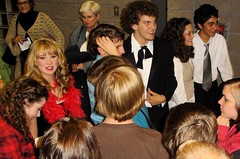
Emily Derozier, Elizabeth Wuellner, Martin Black, Andrew Wood, Maddie Menefee, Solomon Amiri: Enter Laughing, CMHS, Shreveport
Originally uploaded by trudeau
If you'd like to write an evaluation of the comedy - why it was effective, using examples, where it might have ebeen improved, offering examples - I would enjoy reading it and giving you independent credit.
More photos at Shreveport Faces.
Thursday, November 08, 2007
The lotus footprints of Lord Krishna
Krishna is a deity worshipped across many traditions of Hinduism. He is usually depicted as a young cowherd boy playing a flute (such as in the Bhagavata Purana) or a youthful prince giving philosophical direction (as in the Bhagavad Gita).
Most commonly within Hinduism, Krishna is worshipped as an avatar of Vishnu, who is considered the Supreme God by the Vaishnava schools.
Characteristics of Krishna include a divine incarnation, a pastoral childhood and youth, and life as a heroic warrior and teacher.
avatar: In Hindu philosophy, an avatar (Sanskrit) most commonly refers to the incarnation (bodily manifestation) of a higher being (deva), or the Supreme Being (God) onto planet Earth.
The Sanskrit word avatāra- literally means "descent" (avatarati) and usually implies a deliberate descent into lower realms of existence for special purposes.
Most commonly within Hinduism, Krishna is worshipped as an avatar of Vishnu, who is considered the Supreme God by the Vaishnava schools.
Characteristics of Krishna include a divine incarnation, a pastoral childhood and youth, and life as a heroic warrior and teacher.
avatar: In Hindu philosophy, an avatar (Sanskrit) most commonly refers to the incarnation (bodily manifestation) of a higher being (deva), or the Supreme Being (God) onto planet Earth.
The Sanskrit word avatāra- literally means "descent" (avatarati) and usually implies a deliberate descent into lower realms of existence for special purposes.
Basic asanas of the Hatha yoga vocabulary
Here is a site that offers descriptions and names of numerous asanas.
Lotus position: influence of the Hindu's hatha yoga
Yoga (Sanskrit) is a group of ancient spiritual practices originating in India. As a general term in Hinduism[1] it has been defined as referring to "technologies or disciplines of asceticism and meditation which are thought to lead to spiritual experience and profound understanding or insight into the nature of existence."[2]
Yoga is also intimately connected to the other Indian religions.
Outside India, Yoga is mostly associated with the practice of asanas (postures) of Hatha Yoga or as a form of exercise.
Americans recognize the
Asana: Literally means "seat", and in Patanjali's Sutras refers to seated positions used for meditation. Later, with the rise of Hatha yoga, asana came to refer to all the "postures"
Pranayama: Prāna, life force, or vital energy, particularly, the breath, "āyāma", to lengthen or extend
The Sanskrit term yoga is derived from the Sanskrit root yuj, "to control", "to yoke", or "to unite."
Hindu texts discussing different aspects of yoga include the Upanishads and the Bhagavad Gita.
There are several major branches of Yoga. The asanas and other practices of Hatha Yoga are what Americans know.
Yoga is also intimately connected to the other Indian religions.
Outside India, Yoga is mostly associated with the practice of asanas (postures) of Hatha Yoga or as a form of exercise.
Americans recognize the
Asana: Literally means "seat", and in Patanjali's Sutras refers to seated positions used for meditation. Later, with the rise of Hatha yoga, asana came to refer to all the "postures"
Pranayama: Prāna, life force, or vital energy, particularly, the breath, "āyāma", to lengthen or extend
The Sanskrit term yoga is derived from the Sanskrit root yuj, "to control", "to yoke", or "to unite."
Hindu texts discussing different aspects of yoga include the Upanishads and the Bhagavad Gita.
There are several major branches of Yoga. The asanas and other practices of Hatha Yoga are what Americans know.
Awareness of India and Hindu philosophy in the late 60's
The Beatles as well as Jimi Hendrix led their young fans into a study of India and Hindu culture in the late 60's. We learned about things such as
- gurus
- meditation
- Lotus seating position and yoga
- Hindu mythology, such as Lord Krishna
- Indian kurtas (tunics), sandals and jewelry
- Indian incense
- Nehru jackets
- Indian palette of colors.
Here's a Hendrix quiz for you and your parents . . .
1. City in which Hendrix was born and raised?
2. Category of his late 60's music?
3. Music that was the origin of his style?
4. Type of guitar (brand and model) with which he was most commonly associated?
5. Type of British amplifiers which became his signature amp in his later career?
6. City in which he was discovered and granted a major recording contract?
7. The traditional American song that he revamped for guitar at the Woodstock Fest in 1969?
8. Origin of his guitar gymnastics - playing it behind his back, between his legs, with his teeth?
9. Age at his death?
10. Name of Microsoft co-founder Bill Allen's museum that is largtely a tribute to Hendrix?
1. Seattle
2. psychedelic - long songs, extended improvisation, special effects, influenced by the ingestion of psychotropic substances.
3. The blues.
4. Fender's Stratocaster (a model created in the 1950's). He also played the Gibson Flying V and Les Paul and Gibson acoustics.
5. Marshall amps, though he also played Fender amps.
6. London. He couldn't get a major contract in NYC.
7. Star-spangled Banner.
8. African-American blues artists in juke joints.
9. age 28
10. The EMP, or Experience Music Project. It is a radical building in Seattle located under the Space Needle.
- gurus
- meditation
- Lotus seating position and yoga
- Hindu mythology, such as Lord Krishna
- Indian kurtas (tunics), sandals and jewelry
- Indian incense
- Nehru jackets
- Indian palette of colors.
Here's a Hendrix quiz for you and your parents . . .
1. City in which Hendrix was born and raised?
2. Category of his late 60's music?
3. Music that was the origin of his style?
4. Type of guitar (brand and model) with which he was most commonly associated?
5. Type of British amplifiers which became his signature amp in his later career?
6. City in which he was discovered and granted a major recording contract?
7. The traditional American song that he revamped for guitar at the Woodstock Fest in 1969?
8. Origin of his guitar gymnastics - playing it behind his back, between his legs, with his teeth?
9. Age at his death?
10. Name of Microsoft co-founder Bill Allen's museum that is largtely a tribute to Hendrix?
1. Seattle
2. psychedelic - long songs, extended improvisation, special effects, influenced by the ingestion of psychotropic substances.
3. The blues.
4. Fender's Stratocaster (a model created in the 1950's). He also played the Gibson Flying V and Les Paul and Gibson acoustics.
5. Marshall amps, though he also played Fender amps.
6. London. He couldn't get a major contract in NYC.
7. Star-spangled Banner.
8. African-American blues artists in juke joints.
9. age 28
10. The EMP, or Experience Music Project. It is a radical building in Seattle located under the Space Needle.
Tuesday, November 06, 2007
Make sure you ace the hand-sketched map of India on Thurs
Students must be conversant with the following and able to sketch 15 identifications on a hand-sketched map on Thursday.
Arabian Sea
Indian Ocean
Bay of Bengal
Ganges River
Himalaya Mts.
Mt Everest
China
Nepal
Bangladesh
Sri Lanka
Pakistan
Afghanistan
Mumbai (Bombay)
Delhi
Kolkata (Calcutta)
Agra
Arabian Sea
Indian Ocean
Bay of Bengal
Ganges River
Himalaya Mts.
Mt Everest
China
Nepal
Bangladesh
Sri Lanka
Pakistan
Afghanistan
Mumbai (Bombay)
Delhi
Kolkata (Calcutta)
Agra
Monday, November 05, 2007
Brief reports on India
Brief reports on India will be researched Mon and Tues in the B3 computer lab and delivered on Th, Fri and Mon - in reverse alpha order. See the topics in the next post.
15 pts.
The rubric -
* titling
* at least 5 images
* very brief notes on screen
* documentation (sources) on each page
* typed script
* overall length of 3 minutes duration
The principal goal is to
- read in depth about your topic.
- communicate some of your background to the class.
- keep the presentation brief.
- you may use Powerpoint, PhotoStory or another program.
Save it via flash drive, please.
15 pts.
The rubric -
* titling
* at least 5 images
* very brief notes on screen
* documentation (sources) on each page
* typed script
* overall length of 3 minutes duration
The principal goal is to
- read in depth about your topic.
- communicate some of your background to the class.
- keep the presentation brief.
- you may use Powerpoint, PhotoStory or another program.
Save it via flash drive, please.
Week of Nov 5 - 9: research in the computer lab on India and Pakistan
Mon and Tues we will use the B3 Computer Lab to assemble brief reports on the background and current life of India and Pakistan.
Thur there will be a hand-sketched map quiz on India and its neighbors of some 15 items .
Topics for the brief reports:
1. Aryans and Dravidians
2. Hinduism: the basic concepts
3. Brahman and 3 other deities
4. Indus valley civilization
5. Jainism
6. Sikhism
7. Buddhism
8. British East India Company
9. Queen Victoria and India
10. Mohandas K Gandhi
11. Non-violent protest against the British
12. Massacre at Amritsar
13. Taj Mahal
14. Shah Jahan
15. Bollywood
16. Mother Teresa
17. Delhi
18. Mumbai
19. Kolkata
20. Ganges R
21. Festivals of India - Diwali, etc.
22. Cooking of India
23.Bill Gates in India
24. Timeline of India
25. Islam in India - the Mughals
26. Conflict with Pakistan
27. Caste system
28. Music of India
29. Clothing of India
30. Himalayas
Thur there will be a hand-sketched map quiz on India and its neighbors of some 15 items .
Topics for the brief reports:
1. Aryans and Dravidians
2. Hinduism: the basic concepts
3. Brahman and 3 other deities
4. Indus valley civilization
5. Jainism
6. Sikhism
7. Buddhism
8. British East India Company
9. Queen Victoria and India
10. Mohandas K Gandhi
11. Non-violent protest against the British
12. Massacre at Amritsar
13. Taj Mahal
14. Shah Jahan
15. Bollywood
16. Mother Teresa
17. Delhi
18. Mumbai
19. Kolkata
20. Ganges R
21. Festivals of India - Diwali, etc.
22. Cooking of India
23.Bill Gates in India
24. Timeline of India
25. Islam in India - the Mughals
26. Conflict with Pakistan
27. Caste system
28. Music of India
29. Clothing of India
30. Himalayas
Enter laughing by the CMHS Drama Dept on Wed, Th, Fri at 7 pm: Tyler Krieg, Elizabeth Wuellner, Andrew Wood, Emily Derozier, Shreveport
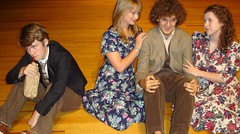
Tyler Krieg, Elizabeth Wuellner, Andrew Wood, Emily Derozier, Shreveport
Originally uploaded by trudeau
7 pm
PAC
Thursday, November 01, 2007
Sitar: the great instrument
The sitar (Hindi/Sanskrit: , Urdu/ ستار) is a plucked stringed instrument. It uses sympathetic strings along with a long hollow neck and a gourd resonating chamber to produce a very rich sound with complex harmonic resonance.
Predominantly used in Hindustani classical, sitar has been ubiquitous in Hindustani classical music since the Middle Ages. This instrument is used throughout the Indian subcontinent, says wikipedia.
A distinctive feature of the sitar are the curved frets, which are movable (allowing fine variation in tuning) and raised (so that resonant strings can run underneath the frets). A typical sitar has 18, 19 or 20 strings (depending on the style) — of which 6 are playable strings, which are situated over the frets. Three of these strings provide the drone and the rest are used to play the melody, though most of the notes of the melody are played on the first string (called the baj tar). The sitar also has 11-16 sympathetic strings running underneath the frets.
The instrument has 2 bridges; the main bridge (the bada goraj) for the playing and drone strings and a smaller, secondary bridge (the chota goraj) for the sympathetic strings that run beneath the main strings.
The sitar may or may not have a secondary resonator, the tumba, near the top of its hollow neck. The sitar's distinctive sound is a result of the way the strings interact with the wide, sloping bridge. This is in contrast to the bridge on a guitar which resembles a knife edge. In a sitar, as a string vibrates, its length changes slightly as its edge touches the bridge, promoting the creation of overtones and giving the sound its distinctive, rich tone.
The materials used in construction include teak wood or tun wood (Cedrela tuna), which is similar to mahogony, for the neck and faceplate, and gourds for the kaddu (the main resonating chamber). The instrument's bridges are made of deer horn, ebony, or very occasionally from camel bone or elephant ivory.
Predominantly used in Hindustani classical, sitar has been ubiquitous in Hindustani classical music since the Middle Ages. This instrument is used throughout the Indian subcontinent, says wikipedia.
A distinctive feature of the sitar are the curved frets, which are movable (allowing fine variation in tuning) and raised (so that resonant strings can run underneath the frets). A typical sitar has 18, 19 or 20 strings (depending on the style) — of which 6 are playable strings, which are situated over the frets. Three of these strings provide the drone and the rest are used to play the melody, though most of the notes of the melody are played on the first string (called the baj tar). The sitar also has 11-16 sympathetic strings running underneath the frets.
The instrument has 2 bridges; the main bridge (the bada goraj) for the playing and drone strings and a smaller, secondary bridge (the chota goraj) for the sympathetic strings that run beneath the main strings.
The sitar may or may not have a secondary resonator, the tumba, near the top of its hollow neck. The sitar's distinctive sound is a result of the way the strings interact with the wide, sloping bridge. This is in contrast to the bridge on a guitar which resembles a knife edge. In a sitar, as a string vibrates, its length changes slightly as its edge touches the bridge, promoting the creation of overtones and giving the sound its distinctive, rich tone.
The materials used in construction include teak wood or tun wood (Cedrela tuna), which is similar to mahogony, for the neck and faceplate, and gourds for the kaddu (the main resonating chamber). The instrument's bridges are made of deer horn, ebony, or very occasionally from camel bone or elephant ivory.
Curry of the day
Curry (from Tamil, one of the languages of Southern India) is the English description of any of a general variety of spicy dishes, says wikipedia.
Curry is most likely an anglicized name for the Kari in Tamil to connotate any secondary dish eaten with rice.
The term curry is now used more broadly, especially in the Western world, to refer to almost any spiced, sauce-based dishes cooked in various south and southeast Asian styles.
Not all curries are made from curry powder.
Commercial spice mixes analagous to curry powder are called Garam masala in Hindi and Nepali.
There is a particular north Indian and Pakistani dish which is given the name curry or kadi and utilizes yoghurt, ghee, and besan. In Northern India and Pakistan, the word "curry" usually means "gravy."
Curry powder, also known as masala powder, is a spice mixture of widely varying composition developed by the British during the Raj as a means of approximating the taste of Indian cuisine at home.
Masala refers to spices, and this is the name given to the thick pasty liquid sauce of combined spices and ghee (clarified butter), butter, palm oil or coconut milk.
Most commercial curry powders available in Britain, the U.S. and Canada rely heavily on ground turmeric, in turn producing a very yellow sauce. Lesser ingredients in these Western yellow curry powders are often coriander, cumin, fenugreek, mustard, chili, black pepper and salt.
It should be reiterated that curry powders and pastes produced and consumed in India are extremely diverse; some red, some yellow, some brown; some with five spices and some with as many as 20 or more.
Curry is most likely an anglicized name for the Kari in Tamil to connotate any secondary dish eaten with rice.
The term curry is now used more broadly, especially in the Western world, to refer to almost any spiced, sauce-based dishes cooked in various south and southeast Asian styles.
Not all curries are made from curry powder.
Commercial spice mixes analagous to curry powder are called Garam masala in Hindi and Nepali.
There is a particular north Indian and Pakistani dish which is given the name curry or kadi and utilizes yoghurt, ghee, and besan. In Northern India and Pakistan, the word "curry" usually means "gravy."
Curry powder, also known as masala powder, is a spice mixture of widely varying composition developed by the British during the Raj as a means of approximating the taste of Indian cuisine at home.
Masala refers to spices, and this is the name given to the thick pasty liquid sauce of combined spices and ghee (clarified butter), butter, palm oil or coconut milk.
Most commercial curry powders available in Britain, the U.S. and Canada rely heavily on ground turmeric, in turn producing a very yellow sauce. Lesser ingredients in these Western yellow curry powders are often coriander, cumin, fenugreek, mustard, chili, black pepper and salt.
It should be reiterated that curry powders and pastes produced and consumed in India are extremely diverse; some red, some yellow, some brown; some with five spices and some with as many as 20 or more.
Om, mantras, chanting and the swastika
Hindu practices generally involve seeking awareness of God and sometimes also seeking blessings from Devas (saints). Therefore, Hinduism has developed numerous practices meant to help one think of divinity in the midst of everyday life.
Hindus can engage in pūjā (worship or veneration),[22]) either at home or at a temple. At home, Hindus often create a shrine with icons dedicated to the individual's chosen form(s) of God.
Visiting temples is not obligatory,[74] In fact, many visit temples only during religious festivals. Hindus perform their worship through icons (murtis). The icon serves as a tangible link between the worshiper and God.[75]
The syllable Om (which represents the Parabrahman) and the Swastika sign (which symbolizes auspiciousness) have grown to represent Hinduism itself, while other markings such as tilaka identify a follower of the faith. Hinduism associates many symbols, which include the lotus, chakra and veena, with particular deities.
Mantras are invocations, praise and prayers that through their meaning, sound, and chanting style help a devotee focus the mind on holy thoughts or express devotion to God/the deities.
Many devotees perform morning ablutions at the bank of a sacred river while chanting the Gayatri Mantra or Mahamrityunjaya mantras. The epic Mahabharata extolls Japa (ritualistic chanting) as the greatest duty in the Kali Yuga (what Hindus believe to be the current age). Many adopt Japa as their primary spiritual practice.
Hindus can engage in pūjā (worship or veneration),[22]) either at home or at a temple. At home, Hindus often create a shrine with icons dedicated to the individual's chosen form(s) of God.
Visiting temples is not obligatory,[74] In fact, many visit temples only during religious festivals. Hindus perform their worship through icons (murtis). The icon serves as a tangible link between the worshiper and God.[75]
The syllable Om (which represents the Parabrahman) and the Swastika sign (which symbolizes auspiciousness) have grown to represent Hinduism itself, while other markings such as tilaka identify a follower of the faith. Hinduism associates many symbols, which include the lotus, chakra and veena, with particular deities.
Mantras are invocations, praise and prayers that through their meaning, sound, and chanting style help a devotee focus the mind on holy thoughts or express devotion to God/the deities.
Many devotees perform morning ablutions at the bank of a sacred river while chanting the Gayatri Mantra or Mahamrityunjaya mantras. The epic Mahabharata extolls Japa (ritualistic chanting) as the greatest duty in the Kali Yuga (what Hindus believe to be the current age). Many adopt Japa as their primary spiritual practice.
Brahman and nirvana
The cycle of action, reaction, birth, death, and rebirth is a continuum called samsara. The notion of reincarnation and karma is a strong premise in Hindu thought. The Bhagavad Gita states that:
“ As a person puts on new clothes and discards old and torn clothes,
similarly an embodied soul enters new material bodies, leaving the old bodies.(B.G. 2:22)[32]
”
Samsara provides ephemeral pleasures, which lead people to desire rebirth to enjoy the pleasures of a perishable body. However, escaping the world of samsara through moksha (liberation) is believed to ensure lasting happiness and peace.[33][34] It is thought that after several reincarnations, an atman eventually seeks unity with the cosmic spirit (Brahman/Paramatman).
The ultimate goal of life, referred to as moksha, nirvana or samadhi, is understood in several different ways: as the realization of one's union with God; as realization of one's eternal relationship with God; realization of the unity of all existence; perfect unselfishness and knowledge of the Self; attainment of perfect mental peace; or as detachment from worldly desires. Such a realization liberates one from samsara and ends the cycle of rebirth.
“ As a person puts on new clothes and discards old and torn clothes,
similarly an embodied soul enters new material bodies, leaving the old bodies.(B.G. 2:22)[32]
”
Samsara provides ephemeral pleasures, which lead people to desire rebirth to enjoy the pleasures of a perishable body. However, escaping the world of samsara through moksha (liberation) is believed to ensure lasting happiness and peace.[33][34] It is thought that after several reincarnations, an atman eventually seeks unity with the cosmic spirit (Brahman/Paramatman).
The ultimate goal of life, referred to as moksha, nirvana or samadhi, is understood in several different ways: as the realization of one's union with God; as realization of one's eternal relationship with God; realization of the unity of all existence; perfect unselfishness and knowledge of the Self; attainment of perfect mental peace; or as detachment from worldly desires. Such a realization liberates one from samsara and ends the cycle of rebirth.
Varanasi, the holiest city on the holy Ganges River
Karma translates literally as action, work or deed[29] and can be described as the "moral law of cause and effect".[30]
According to the Upanishads, an individual, known as the jiva-atma, develops sanskaras (impressions) from actions, whether physical or mental. The "linga sharira", a body more subtle than the physical one, but less subtle than the soul, retains impressions, carrying them over into the next life, establishing a unique trajectory for the individual.[31]
Thus, the concept of a universal, neutral and never-failing karma intrinsically relates to reincarnation as well as one's personality, characteristics and family. Karma threads together the notions of free will and destiny.
According to the Upanishads, an individual, known as the jiva-atma, develops sanskaras (impressions) from actions, whether physical or mental. The "linga sharira", a body more subtle than the physical one, but less subtle than the soul, retains impressions, carrying them over into the next life, establishing a unique trajectory for the individual.[31]
Thus, the concept of a universal, neutral and never-failing karma intrinsically relates to reincarnation as well as one's personality, characteristics and family. Karma threads together the notions of free will and destiny.
A Hindu's evening prayers
Hinduism is the world's oldest extant religion,[4][5] and many of whose origins can be traced to the ancient Vedic civilization.[6] A conglomerate of diverse beliefs and traditions, Hinduism has no single founder.[7][8] It is the world's third largest religion following Christianity and Islam, with approximately a billion adherents, of whom about 905 million live in India and Nepal.[9] Other countries with large Hindu populations include Bangladesh, Sri Lanka, Pakistan, Indonesia, Malaysia, Singapore, Mauritius, Fiji, Suriname, Guyana and Trinidad and Tobago.
Hinduism is an extremely diverse religion. Although some tenets of the faith are accepted by most Hindus, scholars have found it difficult to identify any doctrines with universal acceptance among all denominations.[13] Prominent themes in Hindu beliefs include Dharma (ethics/duties), Samsāra (The continuing cycle of birth, life, death and rebirth), Karma (action and subsequent reaction), Moksha (liberation from samsara), and the various yogas (paths or practices).
Hinduism is an extremely diverse religion. Although some tenets of the faith are accepted by most Hindus, scholars have found it difficult to identify any doctrines with universal acceptance among all denominations.[13] Prominent themes in Hindu beliefs include Dharma (ethics/duties), Samsāra (The continuing cycle of birth, life, death and rebirth), Karma (action and subsequent reaction), Moksha (liberation from samsara), and the various yogas (paths or practices).
Lord Ganesh, one of the widely-popular Hindu gods
Ganesha, also spelled Ganesa or Ganesh, (also known as Ganapati and Vinayaka) is one of the best-known and most worshipped deities in Hinduism[5] and India.[6] Hindu sects worship him regardless of other affiliations.[7] Devotion to Ganesha is widely diffused and extends to Jains, Buddhists, and beyond India, says wikipedia.org.[8]
Although he is known by many attributes, Ganesha's elephant head makes him easy to identify.[9] Ganesha is widely revered as the Remover of Obstacles[10] and more generally as Lord of Beginnings and Lord of Obstacles (Vighnesha, Vighneśvara),[11] patron of arts and sciences, and the deva of intellect and wisdom.[12] He is honoured at the start of rituals and ceremonies and invoked as Patron of Letters during writing sessions.[13] Several texts relate mythological anecdotes associated with his birth and exploits and explain his distinct iconography.
Although he is known by many attributes, Ganesha's elephant head makes him easy to identify.[9] Ganesha is widely revered as the Remover of Obstacles[10] and more generally as Lord of Beginnings and Lord of Obstacles (Vighnesha, Vighneśvara),[11] patron of arts and sciences, and the deva of intellect and wisdom.[12] He is honoured at the start of rituals and ceremonies and invoked as Patron of Letters during writing sessions.[13] Several texts relate mythological anecdotes associated with his birth and exploits and explain his distinct iconography.
The Cuisine of China and India: Cilantro and Tamarind Chutneys
See this Times review on the Indian restaurant until recently called Utsav - now called Indigo Indian Bistro.
You may pursue independent writing by describing what you learned at an Indian restaurant.
India's Restaurant is on Youree (the service road) near King's Hwy. 318-349-0256.
You may pursue independent writing by describing what you learned at an Indian restaurant.
India's Restaurant is on Youree (the service road) near King's Hwy. 318-349-0256.
Subscribe to:
Posts (Atom)
